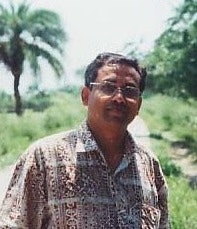Raising Awareness of the Sundarban Ecologically Critical Area, Bangladesh
 The Sundarbans in Central Asia is a region covering some 10,000 sq. km of mangrove forest and water, of which some 40% is in India and the rest in Bangladesh. Part of the world’s largest delta, the area has been formed over centuries from sediments deposited by the Ganges, Brahmaputra and Meghna rivers, which converge on the Bengal Basin. The whole Sundarbans area is intersected by an intricate network of interconnecting waterways, of which the larger channels are often a mile or more in width. The unique hydrology of the Sundarbans, in addition to its great biodiversity, makes it an area of great importance to the millions of people who rely on the watershed daily for water, food and as a source of income.
The Sundarbans in Central Asia is a region covering some 10,000 sq. km of mangrove forest and water, of which some 40% is in India and the rest in Bangladesh. Part of the world’s largest delta, the area has been formed over centuries from sediments deposited by the Ganges, Brahmaputra and Meghna rivers, which converge on the Bengal Basin. The whole Sundarbans area is intersected by an intricate network of interconnecting waterways, of which the larger channels are often a mile or more in width. The unique hydrology of the Sundarbans, in addition to its great biodiversity, makes it an area of great importance to the millions of people who rely on the watershed daily for water, food and as a source of income.
Despite a declaration by the Bangladeshi Government’s Department of Environment in 1999 making the Sundarban an Ecologically Critical Area (ECA) under the Environment Conservation Act 1995, this sensitive area continues to suffer over-exploitation. Illegal urban development continues, including the use of bulldozers to extract sand at the confluence of Kalagachi and Chuna River at Burigoalini Range, within the Sundarban ECA.
 Mowdudur, together with a small committed team from the Centre for Coastal Environmental Conservation, has established a project which aims to raise public awareness of the ECA and its status as a UNESCO World Heritage Site. By putting forward ideas for sustainability in the Sundarban, and by raising awareness of the protection needs of its ecosystems and biodiversity among stakeholders and government agencies, Mowdudur is confident that people can be brought together to end the harmful activities which are threatening future livelihoods.
Mowdudur, together with a small committed team from the Centre for Coastal Environmental Conservation, has established a project which aims to raise public awareness of the ECA and its status as a UNESCO World Heritage Site. By putting forward ideas for sustainability in the Sundarban, and by raising awareness of the protection needs of its ecosystems and biodiversity among stakeholders and government agencies, Mowdudur is confident that people can be brought together to end the harmful activities which are threatening future livelihoods.
Mowdudur’s work focuses on increasing sustainability within an outstanding coastal area of the Sundarban and stemming the decrease seen in Olive Ridley Turtle populations. Working closely with local people and supported by a strong publicity campaign, the team is introducing Turtle Excluder Devices (TEDs) to fishermen and discouraging the use of basic drift nets in an effort to reduce the number of turtles killed unnecessarily through bycatch each year. An education programme targeting crab collectors has also been initiated to raise awareness of the negative impact egg collection is having on future populations of turtle. Beyond the fishermen, 1,500 members of the wider community of Dubla Rash Mela have also been made aware of the existence of the ECA and the harmful activities that are prohibited under the Bangladesh Wildlife Preservation Act.
 Despite facing threats by the contractors associated with sand heap development, Mowdudur has successfully formed a Sundarban Ecologically Critical Area (ECA) Conservation Committee with representatives of the key agencies involved in promoting sustainable development in Bangladesh. Together they are laying out a work plan for the future with clear objectives for how sustainability can be achieved. Six major meetings and 18 campaigns are planned between July 2005 and June 2006, and there are also plans to target 900 critical and influential people, including Government officials and local government representatives, over the course of 2006.
Despite facing threats by the contractors associated with sand heap development, Mowdudur has successfully formed a Sundarban Ecologically Critical Area (ECA) Conservation Committee with representatives of the key agencies involved in promoting sustainable development in Bangladesh. Together they are laying out a work plan for the future with clear objectives for how sustainability can be achieved. Six major meetings and 18 campaigns are planned between July 2005 and June 2006, and there are also plans to target 900 critical and influential people, including Government officials and local government representatives, over the course of 2006.




